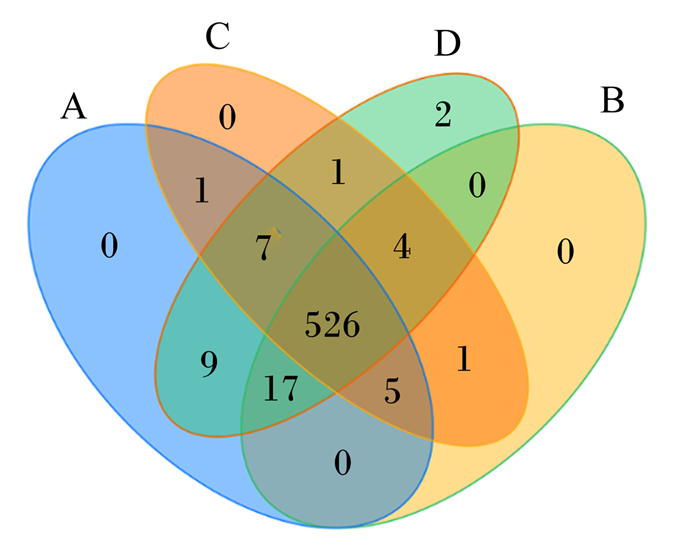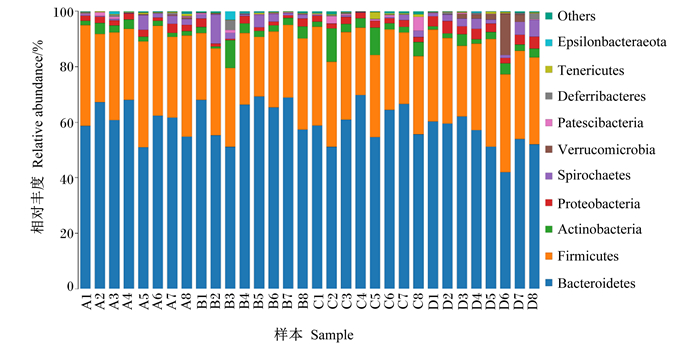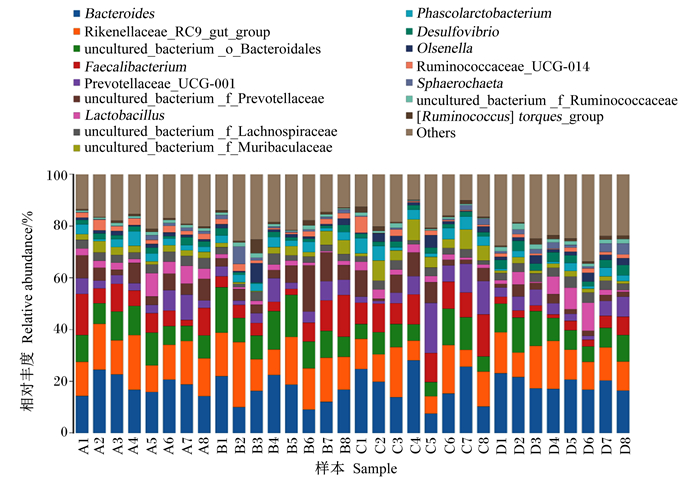2. 陕西省佳县通镇区域农牧技术推广站, 佳县 719208;
3. 正定县桑产业应用研究所, 正定 050800;
4. 陕西省佳县王家砭镇区域农牧技术推广站, 佳县 719208;
5. 河北农业大学信息科学与技术学院, 保定 071001
2. Regional Agricultural and Animal Husbandry Technology Extension Station, Tong Town, Jia County, Shaanxi Province, Jia County 719208, China;
3. Zhengding County Mulberry Industry Application Research Institute, Zhengding 050800, China;
4. Regional Agricultural and Animal Husbandry Technology Extension Station, Wangjiabian Town, Jia County, Shaanxi Province, Jia County 719208, China;
5. College of Information Science and Technology, Agricultural University of Hebei, Baoding 071001, China
畜牧业发展现已进入新时代,但抗生素滥用等问题严重危害畜牧业健康发展,随着限抗政策正式落地,寻找高效绿色的抗生素替代品迫在眉睫。桑叶提取物作为一种新型植物提取物备受关注,其主要成分有桑叶多糖、桑叶黄酮、1-脱氧野尻霉素等,这些生物活性物质具有调节免疫力、降血糖、抗氧化、抗凝血等作用[1-5]。章学东等[6]和邱时秀等[7]研究表明,饲粮中添加桑叶粉可显著提高蛋鸡的生产性能;邱时秀等[8]研究表明,饲粮中添加6%~9%桑枝叶干粉可显著增强彭县黄鸡机体免疫应答水平;邝哲师等[9]研究表明,饲粮添加5%或10%桑叶粉可显著降低胡须鸡盲肠大肠杆菌数量,改善肠道健康。目前,生产实践中主要研究桑叶及发酵桑叶在动物生产中的应用,针对桑叶提取物在蛋鸡生产中的应用研究报道则较少。因此,本试验拟在饲粮中添加不同水平的桑叶提取物(主要成分为桑叶多糖),研究其对蛋鸡生产性能、免疫功能、肠道组织形态及盲肠菌群结构的影响,为桑叶提取物在蛋鸡生产中的应用提供参考依据。
1 材料与方法 1.1 试验设计本试验采用单因素随机试验设计,选取健康状况良好且长势相近的38周龄罗曼灰蛋鸡288只,随机分成4个组,每组6个重复,每个重复12只鸡。试验预试期14 d,正试期56 d。预试期内所有鸡饲喂基础饲粮,正试期内对照组饲喂基础饲粮,3个试验组则在基础饲粮中分别添加0.4%、0.8%、1.2%的桑叶提取物。试验所用桑叶提取物由河北某生物科技公司提供,为墨绿色粉末状,以二氧化硅为载体,主要活性成分为桑叶多糖(20%)、桑叶黄酮(3%)、生物碱(2%)。基础饲粮配制参照中华人民共和国农业行业标准《鸡饲养标准》(NY/T 33—2004)和《新型罗曼商品蛋鸡饲养管理手册》,其组成及营养水平见表 1。
|
|
表 1 基础饲粮组成及营养水平(风干基础) Table 1 Composition and nutrient levels of the basal diet (air-dry basis) |
本次试验场地为河北农业大学畜牧学教学基地,蛋鸡采用3层半开放式阶梯笼养,自由采食和饮水。场地采用自然通风方式,自然+人工光照,光照时间16 h,光照强度15 lx。每日15:00收集1次鸡蛋并记录鸡群的精神状况和病死情况。定时打扫鸡舍。
1.3 样品采集试验第56天,每个重复随机选取2只,共48只鸡,遵循动物福利化屠宰流程对鸡只进行屠宰。打开腹腔,分离出十二指肠、空肠和回肠,在每段肠道中段取3 cm左右肠道样品,用生理盐水将肠道内容物冲洗干净,放到4%甲醛溶液中常温保存,以备制作石蜡切片。无菌采集回肠黏膜及盲肠内容物放入冻存管,-80 ℃保存备用。
1.4 测定指标 1.4.1 生产性能每天记录产蛋数、鸡只数,按重复称量鸡蛋重量。每周以重复为单位计算产蛋率、平均蛋重、平均日采食量以及料蛋比。
1.4.2 肠道免疫指标使用试剂盒(上海江莱生物科技有限公司)测定回肠黏膜中免疫球蛋白A(IgA)、免疫球蛋M(IgM)、免疫球蛋白G(IgG)、补体3(C3)、补体4(C4)、干扰素-γ(IFN-γ)、肿瘤坏死因子-α(TNF-α)、白细胞介素-2(IL-2)、白细胞介素-4(IL-4)含量,严格按照说明书操作。
1.4.3 肠道组织形态制作切片的具体操作为固定、石蜡包埋、切片、苏木精-伊红(HE)染色和封固,采用正置光学显微镜测定绒毛高度(villus height,VH)和隐窝深度(crypt depth,CD),计算绒隐比(villus height/crypt depth ratio,V/C):

|
每组选取8只蛋鸡的盲肠内容物进行盲肠菌群结构分析。采用HiSeq 2500高通量测序技术对盲肠微生物16S rDNA基因全长进行测序,由北京百迈克生物科技有限公司完成。测序流程为:使用德国MN公司的NucleoSpin 96 Soil(4×96)试剂盒提取样品总细菌DNA后,根据16S rDNA全长引物27F和1492R,合成带有Barcode的特异引物,进行PCR扩增并对其产物进行纯化、定量和均一化形成测序文库(SMRT Bell),建好的文库先进行文库质检,质检合格的文库用PacBio Sequel进行测序。将PacBio下机数据导出为CCS文件(CCS序列使用Pacbio提供的smrtlink工具获取)后,进行如下3个步骤的操作。
1) CCS识别:使用lima v1.7.0软件,通过Barcode对CCS进行识别,得到的Barcode-CCS序列数据;
2) CCS长度过滤:使用百迈客公司自主研发的软件,对Barcode-CCS进行过滤,得到有效序列;
3) 去除嵌合体:使用UCHIME v4.2软件,鉴定并去除嵌合体序列,得到Optimization-CCS序列。
对序列信息进行操作分类单元(OTU)、多样性及差异性分析。
1.5 数据处理与分析试验数据采用Office 365进行整理,应用SPSS 25.0统计软件的单因素方差分析(one-way ANOVA)程序对试验数据进行分析,并采用Duncan氏法进行组间的多重比较。试验数据以“平均值±标准差”表示,P < 0.05表示差异显著。
2 结果与分析 2.1 桑叶提取物对蛋鸡生产性能的影响由表 2可知,与对照组相比,饲粮中添加0.4%、0.8%或1.2%的桑叶提取物对蛋鸡平均日采食量、产蛋率、料蛋比和平均蛋重均无显著影响(P>0.05)。
|
|
表 2 桑叶提取物对蛋鸡生产性能的影响 Table 2 Effects of mulberry leaf extract on performance of laying hens |
由表 3可知,与对照组相比,饲粮中添加0.4%、0.8%或1.2%的桑叶提取物对回肠黏膜中IgA、IgM、IgG、C3、C4、TNF-α、IFN-γ及IL-2含量均无显著影响(P>0.05),但可显著提高回肠黏膜中IL-4含量(P<0.05)。
|
|
表 3 桑叶提取物对蛋鸡肠道免疫功能的影响 Table 3 Effects of mulberry leaf extract on intestinal immune function of laying hens |
由表 4可知,与对照组相比,饲粮中添加0.4%、0.8%或1.2%的桑叶提取物可显著增加十二指肠、空肠、回肠绒毛高度及回肠绒隐比(P<0.05),饲粮中添加1.2%的桑叶提取物可显著降低空肠隐窝深度(P<0.05),饲粮中添加0.4%或1.2%的桑叶提取物可显著降低回肠隐窝深度并显著提高空肠绒隐比(P<0.05)。
|
|
表 4 桑叶提取物对蛋鸡肠道组织形态的影响 Table 4 Effects of mulberry extract on intestinal tissue morphology of laying hens |
使用Usearch软件对Reads在97.0%的相似度水平下进行聚类,获得OTU。维恩图(Venn diagram)重叠部分为共有特征数目,非重叠部分为特有特征数目。由图 1可知,试验组与对照组共有OTU数为526个。

|
A:0.4%桑叶提取物组;B:0.8%桑叶提取物组;C为1.2%桑叶提取物组;D:对照组。 A: 0.4% mulberry leaf extract group; B: 0.8% mulberry leaf extract group; C: 1.2% mulberry leaf extract group; D: control group. 图 1 盲肠内容物OTU维恩图 Fig. 1 OTU Venn diagram of cecal content |
根据物种分类学注释结果,盲肠菌群在门水平上的相对丰度如图 2所示,在属水平上的相对丰度如图 3所示。由图 2可知,对照组与试验组蛋鸡盲肠菌群中相对丰度大于1%的菌门有拟杆菌门(Bacteroidetes)、厚壁菌门(Firmicutes)、放线菌门(Actinobacteria)、变形菌门(Proteobacteria)、螺旋体门(Spirochaetes)、疣微菌门(Verrucomicrobia)。由表 5可知,与对照组相比,各试验组盲肠菌群中变形菌门的相对丰度均显著降低(P<0.05),其余菌门的相对丰度均无显著变化(P>0.05)。由图 3可知,对照组与试验组蛋鸡盲肠菌群中相对丰度大于1%的菌属有拟杆菌属(Bacteroides)、理研菌科RC9肠道群(Rikenellaceae_RC9_gut_group)、粪杆菌属(Faecalibacterium)、普雷沃氏菌科UCG-001(Prevotellaceae_UCG-001)、考拉杆菌属(Phascolarctobacterium)等。由表 5可知,与对照组相比,饲粮中添加0.4%或1.2%的桑叶提取物可显著提高盲肠菌群中粪杆菌属的相对丰度(P<0.05),饲粮中添加1.2%的桑叶提取物可显著提高盲肠菌群中考拉杆菌属的相对丰度(P<0.05)。

|
Others:其他;Tenericutes:软壁菌门;Deferribacteres:互养菌门;Verrucomicrobia:疣微菌门;Spirochaetes:螺旋体门;Proteobacteria:变形菌门;Actinobacteria:放线菌门;Firmicutes:厚壁菌门;Bacteroidetes:拟杆菌门。 图 2 门水平上盲肠菌群组成 Fig. 2 Composition of cecal microflora at phylum level |

|
Bacteroides:拟杆菌属;Rikenellaceae_RC9_gut_group:理研菌科RC9肠道群;Faecalibacterium:粪杆菌属;Prevotellaceae_UCG-001:普雷沃氏菌科UCG-001;Lactobacillus:乳杆菌属;Phascolarctobacterium:考拉杆菌属;Desulfovibrio:脱硫弧菌属;Olsenella:欧陆森氏菌属;Ruminococcaceae_UCG-014:瘤胃球菌科UCG-014;Sphaerochaeta:鳞球菌属;Others:其他。 图 3 属水平上盲肠菌群组成 Fig. 3 Composition of cecal microflora at genus level |
|
|
表 5 桑叶提取物对蛋鸡盲肠菌群在门和属水平上相对丰度的影响 Table 5 Effects of mulberry leaf extract on relative abundances of cecal microflora at phylum and genus levels of laying hens |
目前,针对饲粮中添加桑叶及其提取物是否会对畜禽生产性能产生影响尚无统一定论。Zhao等[10]和呼红梅等[11]研究表明,饲粮中添加桑叶多糖对仔猪的平均日采食量、平均日增重及饲料转化率均无显著影响。雷春龙等[12]研究表明,饲粮中添加桑枝叶提取物对罗曼粉蛋鸡的平均日采食量无显著影响,但添加0.4%与0.8%桑枝叶提取物可显著提高产蛋率并显著降低料蛋比。本试验结果表明,饲粮中添加0.4%~1.2%的桑叶提取物不会对蛋鸡生产性能造成不良影响,且有使料蛋比降低的趋势。新鲜桑叶中含有诸如单宁(5.32 mg/kg)和植酸(488.9 mg/kg)等抗营养因子,直接饲喂会影响畜禽采食,降低生产性能,严重时还会发生中毒的情况[3, 13]。使用桑叶提取物则可有效避免此类问题,因此本试验对蛋鸡生产性能未造成不良影响。
3.2 桑叶提取物对蛋鸡肠道免疫功能的影响肠道免疫功能与肠道健康有着密切联系。IL-4是Ⅱ型辅助T细胞分泌的细胞因子,在调节体液免疫中起关键作用[14]。IL-4含量升高可反映出机体免疫应答水平的提升。IgM是由浆细胞完整分泌的一类免疫球蛋白,产生于初次体液免疫反应并起抗原受体作用[15]。Chen等[16]研究表明,在体内试验中纯化Ⅱ型桑叶多糖(MLP-2)能明显提升蛋鸡气管与空肠黏膜中IL-2、IFN-γ和分泌型免疫球蛋白A(sIgA)的表达水平,促进盲肠中IgA+细胞的产生,从而增强蛋鸡气管和肠道的免疫功能。冯麒凤等[17]研究表明,饲粮中添加0.75%的桑叶提取物可显著提高大鲵肠道免疫相关基因雷帕霉素靶蛋白(TOR)、IL-4、多聚免疫球蛋白受体(pIgR)、Toll样受体2(TLR2)、髓样分化因子88(MyD88)和白细胞介素-1受体相关激酶4(IRAK4)的表达量。许祯莹等[18]研究表明,饲粮中添加3%、6%、9%或12%的桑叶粉可显著提高罗曼褐蛋鸡血清中IgA、IgG、IgM、白细胞介素-1(IL-1)及白细胞介素-6(IL-6)含量,且随着添加水平增加而呈现上升的趋势。雷春龙等[12]研究表明,饲粮中添加0.2%、0.4%或0.8%的桑枝叶提取物可显著提高罗曼粉蛋鸡血清中IgG含量,添加0.4%或0.8%的桑枝叶提取物还可显著提高血清中IgA、IgM、IL-6和TNF-α含量。桑叶多糖可增强非特异性免疫、体液免疫及细胞免疫等免疫功能[19-21]。本研究结果表明,饲粮中添加0.8%桑叶提取物可显著提高罗曼褐蛋鸡回肠黏膜中IL-4含量,且IgM有升高的趋势,提示桑叶提取物可增强蛋鸡肠道免疫功能,改善肠道健康。
3.3 桑叶提取物对蛋鸡肠道组织形态的影响肠道消化能力可以通过小肠绒毛高度、隐窝深度及绒隐比进行评价[22-25]。当小肠绒毛高度增高时,会扩大小肠黏膜与食糜表面积,有助于提升肠道消化能力[26]。隐窝深度反映了小肠上皮细胞的成熟速率,隐窝变浅表明小肠上皮细胞的成熟速率增加,分泌功能增强[27]。绒隐比反映了肠道整体生理形态与功能状态,绒隐比升高表明肠道吸收功能在增强[24, 28]。本研究结果显示,饲粮中添加0.2%、0.4%或0.8%的桑叶提取物均可显著提高蛋鸡十二指肠、空肠、回肠绒毛高度及回肠绒隐比,饲粮中添加1.2%的桑叶提取物可显著降低空肠隐窝深度,饲粮中添加0.4%或1.2%桑叶提取物可显著降低回肠隐窝深度并显著提高空肠绒隐比。上述结果提示,桑叶提取物可以有效改善蛋鸡肠道内环境,促进小肠消化吸收,保障肠道健康。张金龙等[29]研究表明,饲粮中添加2%发酵桑叶粉可显著提升42日龄罗斯308肉鸡空肠和回肠绒毛高度。有学者发现多糖类物质作为天然强抗氧化剂,可直接清除机体内脂质过氧化物和超氧离子自由基[12]。Wang等[30]研究表明,桑叶多糖具有明显的清除自由基活性,且呈剂量效应关系,桑叶多糖在0.05~1.00 mg/mL范围内浓度越大,自由基清除活性越高。因此我们推测饲粮中添加的桑叶提取物可能作为抗氧化剂增强肠道免疫功能,维持蛋鸡肠道组织形态结构。此外,谢红兵[31]研究表明,植物多糖可促进小肠葡萄糖相关转运蛋白表达,激活相关信号通路促进上皮细胞增殖,进而提升肠道消化吸收功能。桑叶提取物改善肠道健康的具体机制还不清楚,需进一步试验验证。
3.4 桑叶提取物对蛋鸡盲肠菌群结构的影响肠道健康与肠道内菌群结构息息相关,肠道菌群不仅参与消化道消化吸收过程,还参与抵御外来细菌对机体的入侵,起着生物屏障作用[32-34]。肠道菌群结构变化受到诸如畜禽个体、饲养环境、饲粮配比等的影响[35]。诸多研究表明,植物多糖可以调节畜禽肠道菌群结构,改善肠道健康[33, 35-36]。
程冉冉[37]研究表明,蛋鸡盲肠菌群中的优势菌门为拟杆菌门、厚壁菌门和放线菌门,本试验结果与此一致。王文文等[38]研究表明,饲粮中添加400 mg/kg BW发酵麸皮多糖可使肉羊瘤胃菌群中变形菌门的相对丰度显著降低。变形菌门中包括诸多致病菌,降低变形菌门的相对丰度有利于肠道健康[39]。本试验中,饲粮中添加0.2%、0.4%或0.8%的桑叶提取物均可显著降低蛋鸡盲肠菌群中变形菌门的相对丰度,说明桑叶提取物抑制了蛋鸡盲肠菌群中有害菌的生长。粪杆菌属在肠道菌群中的相对丰度可以衡量肠道健康状况,粪杆菌属可以生产丁酸盐,丁酸盐能够协调机体抵御外来病原体入侵,降低机体炎症反应,一定范围内其相对丰度越高说明肠道内环境越健康[40-41]。考拉菌属属于厚壁菌门,通常为有益菌[42]。本试验中,饲粮中添加0.4%或1.2%的桑叶提取物均可显著升高蛋鸡盲肠菌群中粪杆菌属的相对丰度,且添加1.2%的桑叶提取物还可显著升高考拉菌属的相对丰度,表明桑叶提取物改善了蛋鸡的盲肠菌群结构。
4 结论① 饲粮中添加0.4%~1.2%的桑叶提取物对蛋鸡生产性能无不良影响。
② 饲粮中添加0.8%的桑叶提取物可显著提高蛋鸡回肠黏膜中IL-4含量,增强肠道免疫功能。
③ 饲粮中添加0.8%~1.2%的桑叶提取物可改善肠道组织形态和盲肠菌群结构,进而保障肠道健康。
④ 综合分析得出,本试验条件下,在蛋鸡饲粮中添加0.8%的桑叶提取物最为适宜。
| [1] |
CAI M, MU L, WANG Z L, et al. Assessment of mulberry leaf as a potential feed supplement for animal feeding in P. R. China[J]. Asian-Australasian Journal of Animal Sciences, 2019, 32(8): 1145-1152. DOI:10.5713/ajas.18.0671 |
| [2] |
HE X R, FANG J C, RUAN Y L, et al. Structures, bioactivities and future prospective of polysaccharides from Morus alba (white mulberry): a review[J]. Food Chemistry, 2018, 245: 899-910. DOI:10.1016/j.foodchem.2017.11.084 |
| [3] |
陶程. 广西现行桑树品种枝条总生物碱、多糖、总黄酮含量的研究[D]. 硕士学位论文. 南宁: 广西大学, 2018. TAO C. Study on total alkaloid, polysaccharide and total flavonoids content in branches of mulberry species in Guangxi[D]. Master's Thesis. Nanning: Guangxi University, 2018. (in Chinese) |
| [4] |
杨灿, 唐小武, 欧慧敏, 等. 桑叶的营养价值及其在畜禽生产中的应用研究进展[J]. 中国畜牧兽医, 2019, 46(5): 1388-1396. YANG C, TANG X W, OU H M, et al. Research progress on nutritional value of mulberry leaf and its application in animal production[J]. China Animal Husbandry & Veterinary Medicine, 2019, 46(5): 1388-1396 (in Chinese). |
| [5] |
LI J S, JI T, SU S L, et al. Mulberry leaves ameliorate diabetes via regulating metabolic profiling and AGEs/RAGE and p38 MAPK/NF-κB pathway[J]. Journal of Ethnopharmacology, 2022, 283: 114713. DOI:10.1016/j.jep.2021.114713 |
| [6] |
章学东, 李有贵, 张雷, 等. 桑叶粉对蛋鸡生产性能、蛋品质和血清生化指标的影响研究[J]. 中国家禽, 2012, 34(16): 25-28. ZHANG X D, LI Y G, ZHANG L, et al. Effect of dietary mulberry leaves on productive performance, egg quality and serum biochemical indices of laying hens[J]. China Poultry, 2012, 34(16): 25-28 (in Chinese). DOI:10.3969/j.issn.1004-6364.2012.16.006 |
| [7] |
邱时秀, 雷春龙, 李娟, 等. 桑叶粉对蛋鸡生产性能和蛋品质的影响[J]. 黑龙江畜牧兽医, 2017(22): 184-186. QIU S X, LEI C L, LI J, et al. The effect of mulberry leaf powder on the production performance and egg quality of laying hens[J]. Heilongjiang Animal Science and Veterinary Medicine, 2017(22): 184-186 (in Chinese). |
| [8] |
邱时秀, 李娟, 陈亚迎, 等. 桑枝叶干粉对彭县黄鸡生长性能、屠宰性能及抗氧化、免疫功能的影响[J]. 黑龙江畜牧兽医, 2019(10): 111-114. QIU S X, LI J, CHEN Y Y, et al. Effects of dry powder of mulberry branches and leaves on growth performance, slaughter performance, antioxidant and immune functions of Pengxian yellow chickens[J]. Heilongjiang Animal Science and Veterinary Medicine, 2019(10): 111-114 (in Chinese). |
| [9] |
邝哲师, 黄静, 廖森泰, 等. 桑叶粉和发酵桑叶粉对胡须鸡屠宰性能、肉品质及盲肠菌群的影响[J]. 中国畜牧兽医, 2016, 43(8): 1989-1997. KUANG Z S, HUANG J, LIAO S T, et al. Effects of mulberry leaf meal and fermented mulberry leaf meal on slaughter performance, meat quality and cecum microflora in Huxu chicken[J]. China Animal Husbandry & Veterinary Medicine, 2016, 43(8): 1989-1997 (in Chinese). |
| [10] |
ZHAO X J, LI L, LUO Q L, et al. Effects of mulberry (Morus alba L.) leaf polysaccharides on growth performance, diarrhea, blood parameters, and gut microbiota of early-weanling pigs[J]. Livestock Science, 2015, 177: 88-94. DOI:10.1016/j.livsci.2015.03.001 |
| [11] |
呼红梅, 郝丽红, 王怀中, 等. 发酵桑叶对生长育肥猪生长性能、胴体品质和肌肉营养成分的影响[J]. 动物营养学报, 2021, 33(11): 6104-6113. HU H M, HAO L H, WANG H Z, et al. Effects of fermented mulberry leaves on growth performance, carcass quality and muscle nutrients of growing-finishing pigs[J]. Chinese Journal of Animal Nutrition, 2021, 33(11): 6104-6113 (in Chinese). DOI:10.3969/j.issn.1006-267x.2021.11.012 |
| [12] |
雷春龙, 李娟, 吴永胜, 等. 桑枝叶提取物对蛋鸡生产性能、血清免疫指标与抗氧化能力的影响[J]. 中国畜牧杂志, 2019, 55(8): 118-122. LEI C L, LI J, WU Y S, et al. Effects of mulberry branch and leaf extract on growth performance, serum immune indexes and antioxidant capacity of laying hens[J]. Chinese Journal of Animal Science, 2019, 55(8): 118-122 (in Chinese). |
| [13] |
张波, 陈祥宇, 王德贺, 等. 桑叶的营养价值及在动物生产中的应用[J]. 饲料研究, 2021, 44(7): 143-145. ZHANG B, CHEN X Y, WANG D H, et al. Nutritional value of mulberry leaves and its application in animal production[J]. Feed Research, 2021, 44(7): 143-145 (in Chinese). |
| [14] |
张霞. PD-1/PD-Ls在IgG4-RD中作用的研究及过敏/嗜酸性粒细胞升高在IgG4-RD中的意义[D]. 博士学位论文. 北京: 北京协和医学院, 2019. ZHANG X. The role of PD-1/PD-Ls in IgG4-RD and the significance of hypersensitivity/eosinophilia in IgG4-RD[D]. Ph. D. Thesis. Beijing: Peking Union Medical College, 2019. (in Chinese) |
| [15] |
杨春林. 自然杀伤细胞及其亚型在实验性自身免疫性重症肌无力中的免疫调节作用[D]. 博士学位论文. 济南: 山东大学, 2020. YANG C L. Immune-regulation of natural killer cells and their subtypes on experimental autoimmune myasthenia gravis[D]. Ph. D. Thesis. Jinan: Shandong University, 2020. (in Chinese) |
| [16] |
CHEN X L, SHENG Z C, QIU S L, et al. Purification, characterization and in vitro and in vivo immune enhancement of polysaccharides from mulberry leaves[J]. PLoS One, 2019, 14(1): e0208611. DOI:10.1371/journal.pone.0208611 |
| [17] |
冯麒凤, 李战福, 黄先智, 等. 日粮中添加桑叶提取物和1-脱氧野尻霉素对大鲵生长、消化、免疫能力和肠道菌群的影响[J]. 水生生物学报, 2021, 45(3): 582-592. FENG Q F, LI Z F, HUANG X Z, et al. Effects of dietary mulberry leaf extract and 1-deoxynojirimycin on growth, digestion and immunity capacity, and intestinal microorganism of Chinese giant salamander (Andrias davidianus)[J]. Acta Hydrobiologica Sinica, 2021, 45(3): 582-592 (in Chinese). |
| [18] |
许祯莹, 雷春龙, 李娟, 等. 日粮中添加桑叶粉对蛋鸡血液抗氧化和免疫指标的影响[J]. 畜牧与兽医, 2017, 49(12): 34-38. XU Z Y, LEI C L, LI J, et al. Effects of mulberry leaf meal on serum antioxidant indexes and immune indexes of laying hens[J]. Animal Husbandry & Veterinary Medicine, 2017, 49(12): 34-38 (in Chinese). |
| [19] |
AI J, BAO B, BATTINO M, et al. Recent advances on bioactive polysaccharides from mulberry[J]. Food & Function, 2021, 12(12): 5219-5235. |
| [20] |
黄世荣, 洪德志, 李晓童, 等. 桑枝多糖对免疫抑制小鼠的免疫调节作用[J]. 蚕业科学, 2017, 43(3): 467-471. HUANG S R, HONG D Z, LI X T, et al. Immunoregulatory functions of mulberry branch polysaccharides on immunosuppressed mice[J]. Acta Sericologica Sinica, 2017, 43(3): 467-471 (in Chinese). |
| [21] |
洪德志, 张作法, 蒋学, 等. 桑枝多糖对正常小鼠免疫功能的影响[J]. 蚕业科学, 2011, 37(3): 481-485. HONG D Z, ZHANG Z F, JIANG X, et al. Effects of polysaccharide from Ramulus mori on immunologic functions of normal mouse[J]. Acta Sericologica Sinica, 2011, 37(3): 481-485 (in Chinese). DOI:10.3969/j.issn.0257-4799.2011.03.016 |
| [22] |
ABDELATTY A M, MANDOUH M I, MOHAMED S A, et al. Azolla leaf meal at 5% of the diet improves growth performance, intestinal morphology and p70S6K1 activation, and affects cecal microbiota in broiler chicken[J]. Animal, 2021, 15(10): 100362. DOI:10.1016/j.animal.2021.100362 |
| [23] |
SHI H T, ZHAO S Z, WANG K L, et al. Effects of dietary Astragalus membranaceus supplementation on growth performance, and intestinal morphology, microbiota and metabolism in common carp (Cyprinus carpio)[J]. Aquaculture Reports, 2022, 22: 100955. DOI:10.1016/j.aqrep.2021.100955 |
| [24] |
TEJEDA O J, KIM W K. Effects of fiber type, particle size, and inclusion level on the growth performance, digestive organ growth, intestinal morphology, intestinal viscosity, and gene expression of broilers[J]. Poultry Science, 2021, 100(10): 101397. DOI:10.1016/j.psj.2021.101397 |
| [25] |
徐静, 张子儒, 王德贺, 等. 饮水中添加大蒜精油对蛋鸡生长性能、肠道组织形态及盲肠菌群的影响[J]. 动物营养学报, 2021, 33(1): 308-316. XU J, ZHANG Z R, WANG D H, et al. Effects of adding garlic essential oil into drinking water on growth performance, intestinal tissue morphology and cecum microbial flora of layer hens[J]. Chinese Journal of Animal Nutrition, 2021, 33(1): 308-316 (in Chinese). DOI:10.3969/j.issn.1006-267x.2021.01.031 |
| [26] |
王鑫鑫, 李茜茜, 吕毅, 等. 组合蛋白酶对肉仔鸡采食偏好性、血清生化指标和肠道组织形态的影响[J]. 动物营养学报, 2022, 34(1): 264-273. WANG X X, LI X X, LYU Y, et al. Effects of combinatorial protease on feed intake preference, serum biochemical indices and intestinal tissue morphology of broilers[J]. Chinese Journal of Animal Nutrition, 2022, 34(1): 264-273 (in Chinese). DOI:10.3969/j.issn.1006-267x.2022.01.025 |
| [27] |
ZHAO Y Z, FU J H, LI P, et al. Effects of dietary glucose oxidase on growth performance and intestinal health of AA broilers challenged by Clostridium perfringens[J]. Poultry Science, 2022, 101(1): 101553. DOI:10.1016/j.psj.2021.101553 |
| [28] |
XIE Y H, WANG L X, SUN H, et al. Immunomodulatory, antioxidant and intestinal morphology-regulating activities of alfalfa polysaccharides in mice[J]. International Journal of Biological Macromolecules, 2019, 133: 1107-1114. DOI:10.1016/j.ijbiomac.2019.04.144 |
| [29] |
张金龙, 张宁, 杨雪, 等. 发酵桑叶粉对肉鸡生长性能、血清生化指标及肠道组织形态结构的影响[J]. 饲料工业, 2017, 38(20): 38-42. ZHANG J L, ZHANG N, YANG X, et al. Effects of fermented product of mulberry leaf on growth performance, serum biochemical indexes and intestinal morphology of broiler chickens[J]. Feed Industry, 2017, 38(20): 38-42 (in Chinese). |
| [30] |
WANG F, LI J R, JIANG Y M. Polysaccharides from mulberry leaf in relation to their antioxidant activity and antibacterial ability[J]. Journal of Food Process Engineering, 2010, 33(1): 39-50. DOI:10.1111/j.1745-4530.2008.00258.x |
| [31] |
谢红兵. 植物多糖对断奶仔猪肠道生理特征和免疫机能的影响及机理研究[D]. 博士学位论文. 长沙: 湖南农业大学, 2018. XIE H B. Effects and mechanism of botanical polysaccharides on intestinal physiological characteristics and immue function of weaned piglets[D]. Ph. D. Thesis. Changsha: Hunan Agricultural University, 2018. (in Chinese) |
| [32] |
SHREINER A B, KAO J Y, YOUNG V B. The gut microbiome in health and in disease[J]. Current Opinion in Gastroenterology, 2015, 31(1): 69-75. DOI:10.1097/MOG.0000000000000139 |
| [33] |
YIN C M, NORATTO G D, FAN X Z, et al. The impact of mushroom polysaccharides on gut microbiota and its beneficial effects to host: a review[J]. Carbohydrate Polymers, 2020, 250: 116942. DOI:10.1016/j.carbpol.2020.116942 |
| [34] |
李玲, 孙小红, 连旭, 等. 凉茶渣替代象草对育肥牛空肠组织形态、屏障功能以及菌群结构的影响[J]. 动物营养学报, 2022, 34(2): 1087-1097. LI L, SUN X H, LIAN X, et al. Effects of herbal tea residue on ileum morphology, barrier function and flora structure of fattening cattle[J]. Chinese Journal of Animal Nutrition, 2022, 34(2): 1087-1097 (in Chinese). |
| [35] |
TIAN H C, LIANG Y, LIU G B, et al. Moringa oleifera polysaccharides regulates caecal microbiota and small intestinal metabolic profile in C57BL/6 mice[J]. International Journal of Biological Macromolecules, 2021, 182: 595-611. DOI:10.1016/j.ijbiomac.2021.03.144 |
| [36] |
ZHAO R Q, HU Q H, MA G X, et al. Effects of Flammulina velutipes polysaccharide on immune response and intestinal microbiota in mice[J]. Journal of Functional Foods, 2019, 56: 255-264. DOI:10.1016/j.jff.2019.03.031 |
| [37] |
程冉冉. 粪菌移植对鸡生长发育及肠道菌群的影响[D]. 硕士学位论文. 武汉: 华中农业大学, 2020. CHENG R R. The effect of fecal microbiota transplantation on growth performance and gut microbiota in chickens[D]. Master's Thesis. Wuhan: Huazhong Agricultural University, 2020. (in Chinese) |
| [38] |
王文文, 王园, 孟子琪, 等. 发酵麸皮多糖对杜寒杂交肉羊瘤胃菌群及其屏障功能相关指标的影响[J]. 动物营养学报, 2022, 34(1): 640-650. WANG W W, WANG Y, MENG Z Q, et al. Effects of fermented wheat bran polysaccharides on microbiota and rumen barrier junction related indices of Dorper×thin-tailed Han crossbred meat lambs[J]. Chinese Journal of Animal Nutrition, 2022, 34(1): 640-650 (in Chinese). DOI:10.3969/j.issn.1006-267x.2022.01.058 |
| [39] |
孙悦, 戴求仲, 蒋桂韬, 等. 饲粮支链氨基酸比例对28~63日龄攸县麻鸭肠道菌群的影响[J/OL]. 广西师范大学学报(自然科学版): 1-10. (2021-03-29). https://kns.cnki.net/kcms/detail/detail.aspx?FileName=GXSF20210304001&DbName=CAPJ2021.DOI:10.16088/j.issn.1001-6600.2020110901. SUN Y, DAI Q Z, JIANG G T, et al. Effect of dietary branched-chain amino acid ratio on intestinal flora of 28-63 days old Youxian duck[J/OL]. Journal of Guangxi Normal University (Natural Science Edition): 1-10. (2021-03-29). https://kns.cnki.net/kcms/detail/detail.aspx?FileName=GXSF20210304001&DbName=CAPJ2021.DOI:10.16088/j.issn.1001-6600.2020110901. (in Chinese) |
| [40] |
LAURSEN M F, LAURSEN R P, LARNKJÆR A, et al. Faecalibacterium gut colonization is accelerated by presence of older siblings[J]. mSphere, 2017, 2(6): e00448-17. |
| [41] |
李瑞萍, 刘长国, 张硕, 等. 蝉花多糖对肉鸡生长性能、抗氧化能力和肠道菌群的影响[J]. 中国兽医学报, 2021, 41(6): 1118-1126. LI R P, LIU C G, ZHANG S, et al. Effects of Cordyceps cicadae polysaccharide on growth performance, antioxidant capacity and intestinal microbial diversity of broiler chickens[J]. Chinese Journal of Veterinary Science, 2021, 41(6): 1118-1126 (in Chinese). |
| [42] |
HOU D W, HUANG Z J, ZENG S Z, et al. Intestinal bacterial signatures of white feces syndrome in shrimp[J]. Applied Microbiology and Biotechnology, 2018, 102(8): 3701-3709. DOI:10.1007/s00253-018-8855-2 |




